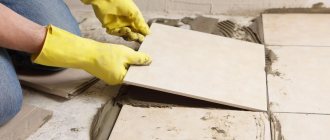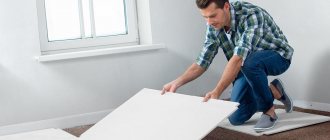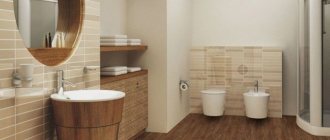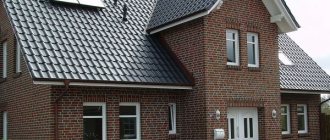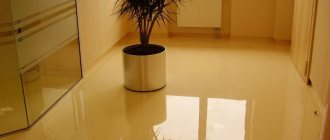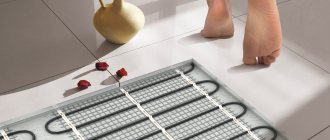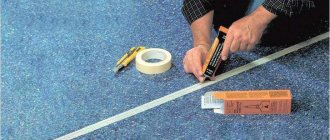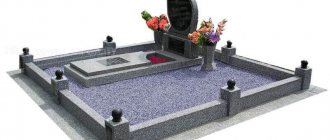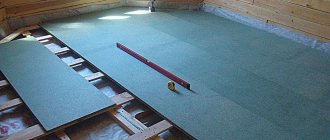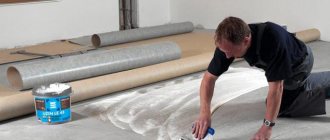Icer
18102 0 12
Icer June 1, 2016Specialization: master in the construction of plasterboard structures, finishing work and laying floor coverings. Installation of door and window units, finishing of facades, installation of electrical, plumbing and heating - I can give detailed advice on all types of work.
There is a misconception among many developers that laying linoleum on fiberboard is not the best option, they say, the surface will deform in a short time. In fact, if the installation is carried out in accordance with the technology, then such a base will serve you for decades. In the review, I will describe the workflow in detail, and if you follow all the recommendations, the result will be excellent.
In the photo: a linoleum floor will be perfectly flat only if the base is prepared very carefully
Why do they put fiberboard under linoleum?
The technology of laying linoleum on the floor over a fiberboard flooring is not new. This type of base became widespread in the USSR and proved to be the best. Currently, it is customary to lay fiberboard in private houses and apartments, as well as on the first floors of multi-story buildings. This is due to the fact that fiberboard has thermal insulation properties and is often used as insulation.
An important advantage of fiberboard is the flat surface of the material. If these slabs are correctly laid on the floor, the resulting flooring will be perfectly flat, suitable for installing almost any covering.
Determining the quality of the old coating
Old linoleum with curved corners laid on a lumpy floor is not the case when you can leave the covering in place and lay a new one on top. There are several reasons for this:
- new linoleum will only emphasize the unevenness of the floor;
- due to the unevenness of the floor, certain areas of the coating will wear out faster than others;
- fungus or mold may form under an old coating of poor quality, so it is better to remove it;
- Even if the floor under the linoleum is smooth, defects in the old coating can form bumps.
If the old linoleum has no defects, is laid on a flat surface and is firmly attached to the base, then dismantling such a covering is not necessary. After all, the surface is smooth and durable, and these are the main requirements for laying linoleum. Moreover, 2 layers of linoleum provide better thermal insulation and durability of the coating.
Consumer properties of fiberboard
Linoleum mounted on a fiberboard base is a wear-resistant floor covering. Installation of such a structure is carried out in a short time: in the case of concrete screeds, you need to wait several months for the cement to dry, while it takes a week to adapt linoleum and fiberboard to operating conditions.
A floor covered with linoleum is resistant to static and dynamic loads of varying strength, depending on the thickness of the linoleum sheet. Together with a fiberboard backing, linoleum provides excellent sound insulation of rooms.
Playground markings
The application of playground markings on linoleum can be done using a two-component polyurethane-based composition.
Since the top layer of the coating has a similar structure, this paint adheres well to the base and holds firmly for a long time even under intense loads. It is best to use those compounds recommended by the sports flooring manufacturer.
The paint is applied to the linoleum in two layers, the second only after the previous one has completely dried. For various formulations this time is 5-8 hours. Since the paint is two-component, its use is limited. Only mix as much as can be applied within the specified period.
For temporary markings during irregular sporting events, you can use self-adhesive marker tapes of various colors. The dimensions of the court, the thickness of the lines and their colors are determined by the standards of the relevant federations of team sports.
Contraindications and errors
Fibreboard is not resistant to moisture. This material has absorbent properties and should only be laid in dry rooms. At high humidity, the coating made from it will wave. To avoid negative consequences, the fiberboard needs to be brought inside the room and simply laid on the floor without securing it. The slabs should rest for 7–10 days. During this time, the material adapts to operating conditions, and it will be possible to begin installation work directly.
Other precautions must be taken. For example, each fiberboard board must be carefully sanded on both sides to create a moisture-proof barrier. Polyethylene is placed on the floor under the slabs - it is desirable that the material be made in the form of a single sheet. If you have to lay several sheets of polyethylene on the floor surface, do not leave gaps between them. After each stage of installation work, the floor is thoroughly dried.
Also, waves appear due to an uneven base under the decking. The floor surface must be leveled, getting rid of too high protrusions. To do this, the wooden covering is usually planed. Fiberboard flooring is not installed on top of concrete floors; it is correct to use self-leveling mixtures to prepare cement screeds for laying linoleum.
Conclusion
Fiberboard is excellent for preparing the base for linoleum; it is important to choose high-quality material and carry out the installation work correctly. The video in this article will clearly show the workflow, and if anything is unclear to you, then ask questions in the comments below the article.
Did you like the article? Subscribe to our Yandex.Zen channel
June 1, 2016
Linoleum, Flooring
If you want to express gratitude, add a clarification or objection, or ask the author something, add a comment or say thank you!
Methods for attaching fiberboard decking
Before laying fiberboard panels on the plank floor, the cracks in the base are treated with putty. The joints between the boards are filled with acrylic sealant - this will increase the thermal insulation properties of the floor covering.
Fiberboard sheets are attached to the surface of the plank floor with nails or self-tapping screws. The disadvantage of this technology is the appearance of irregularities in the places where the heads of the fasteners are located. To avoid this, recesses are made in the surface of the panels so that the self-tapping screws are placed there along with the caps. Irregularities that form after installation of fasteners can be removed using putty.
Another option is to glue the flooring, but a suitable base for this is not a plank floor, but a concrete one. Tar, boiled drying oil or special glue are used as an adhesive. However, installation of fiberboard boards using adhesives is carried out in exceptional cases, since this technology is impractical.
Marking
Today you can find a huge range of fiberboard boards on the market. In order not to get lost in their diversity, you should focus on the following markings:
- T - solid slabs, the front surface was not additionally refined;
- T-P – frontal surface is tinted;
- T-S – the front surface is made of finely dispersed wood pulp;
- T-SP – the front surface is made of tinted wood pulp and painted;
- M-1 – M-3 – soft slabs;
- ST – super-hard slabs, the front surface is not refined;
- ST-S – the front surface is made of finely dispersed wood pulp.
The procedure for preparing the base
Laying fiberboard on the floor begins from the far corner of the room. Work is carried out at room temperature and moderate humidity after the slabs have adapted to operating conditions. Before fixing the fiberboard sheets motionless, you need to make sure that their joints do not create bumps and depressions. If you lay linoleum on such a surface, it will go in waves.
If unevenness is detected after completion of installation work, the floor will have to be leveled. The joints between fiberboard boards are treated with sandpaper and putty. As soon as the putty has dried, you can immediately glue the linoleum to the base. These works are carried out in a short time, 1-2 days. High installation speed is one of the main advantages of fiberboard flooring.
Details
How to prepare fiberboard for installation of linoleum
Material purchased at a construction showroom usually does not require an additional degree of preparation. Due to the fact that the fiberboard is stored horizontally in the stack, the sheet geometry does not require any special modification or adjustment. The only problem may be the dimensions of the slab, and the most popular format of the fiberboard slab has become the size of 2.44 * 1.22 meters. For an ordinary room of 15-18 square meters, just 4 sheets will be needed, and in other cases, the flooring material will need to be cut out in advance to make it more convenient to bring it into the room and lay it on the floors.
Editing geometry
If the fiberboard was purchased in advance and stored in an unheated room, then the sheet geometry was probably damaged. It is imperative to correct the situation before laying fiberboard on the floor surface. Fibreboard should be stored in stacks in dry rooms. To align the sheets you need 2 OSB sheets, polyethylene film and weight:
- The material needs to be slightly moistened with clean water from a hand-held sprayer.
- Cover with plastic wrap on all sides.
- Stack between a pair of OSB panels.
- Load with pressure.
In hot and dry weather, straightening takes a maximum of 72 hours. The fiberboard sheets removed from the general stack must be immediately installed on the floor under the rolled linoleum. A slightly increased degree of humidity only improves the adherence of the slabs to the base. If you plan to treat the material with a protective coating, it will take at least 2 weeks to dry in a stack until it is completely dry from any remaining water.
What to treat before laying slabs under linoleum
How to lay linoleum on fiberboard? Most beginners prefer not to treat the fiberboard before laying it on the floor. It is believed that it is enough to simply lay the sheets on a rough base and let them rest for 5 to 7 days, as in the case of rolling out linoleum. This can help lay fiberboard, but it can also be the root cause of problems because the material can pick up moisture. Everything will depend on the conditions in which you plan to lay linoleum.
Helpful advice! Ideally, immediately after purchasing the material, you should impregnate the fiberboard surface with a wood varnish composition.
Is it necessary to treat fiberboard with drying oil for linoleum?
There is always a problem of how to protect the paper base of the boards from water vapor and moisture. The most inexpensive and simplest method is to use drying oils and oil varnishes. For varnish protection, fiberboard can be treated under linoleum, long before it is time to lay the slabs. Drying oil protects no worse, but takes a long time to dry. For this reason, it is necessary to dry the materials only if the sheets are glued to concrete. Otherwise, the process of laying the material will turn into torture, the drying oil will stain everything. Moreover, not all adhesives make it possible to lay the material on a polyester surface. If you lay the material on drying oil, then after 10-15 years, when the time comes for replacement, you can remove the coating only with the backing.
Laying a wood-fiber base for linoleum
Among other things, it is necessary to properly prepare fiberboard floors. The material can be laid using 3 methods:
- Leave it free.
- Lay on dowels.
- Glue to the base.
One of these methods is selected based on the base material. If linoleum needs to be laid in a country house without a basement and with an earthen floor, then fiberboard cannot be used. Even with insulation and double waterproofing, moisture will reach the wood-fiber base, and the linoleum begins to rot. At a minimum, it is required to make a concrete screed and ventilation.
How to install fiberboard on a concrete surface
Laying fiber boards on a concrete screed is possible only if the cement-sand base is insulated and its surface is waterproofed with an acrylic primer. Fiberboard sheets can be laid on a bitumen or resin base, and the material is laid on a slightly cooled, but slightly viscous base and leveled using the rules. You can lay hardboard under linoleum on a concrete floor using dowels. This method is used if the dimensions of the rough base are very large and the concrete site is not characterized by an ideal surface.
Installing fiber board underlayment on wood
Sequence of laying linoleum
Like fiberboard, linoleum should rest in the room where repairs are being carried out. For this, 2-3 days are enough: during this time the material adapts to the temperature and humidity conditions, and after installation it will not expand or, conversely, contract. Sheets of linoleum are spread on the floor so that they take the correct shape. If the material is going to be laid in strips, you need to make sure that the pattern of the floor covering matches.
Linoleum must be glued to the flooring; it is not recommended to use self-tapping screws: they will ruin the appearance of the floor. To perform installation work, special glue is used. It is applied to the floor using a notched trowel, avoiding lumps and untreated areas. When the glue on the fiberboard boards thickens a little, it is applied to the back side of the linoleum sheets, and then they are laid on the floor surface. To properly distribute the glue under the linoleum surface, the flooring sheets are aligned from the center to the corners.
Often laying linoleum on fiberboard is done in a different way. Instead of gluing the material, it is fixed using a furniture stapler. This tool is designed for working with wood and wood waste boards, and will ensure high reliability of fastenings.
Workflow Description
We’ll figure out what you’ll need when working, how to choose the best material, and what stages are involved in laying fiberboard on different types of surfaces. Everything is quite simple, the main thing is to understand all the nuances and avoid the mistakes that most developers make.
Preliminary stage
At this stage you need to do the following:
First of all, it is necessary to take measurements to determine the required amount of material.
It is important to do this not by eye, otherwise it may turn out that you are missing 1-2 sheets or, conversely, there are several elements left and there is simply nowhere to put them. It is best to make a rough plan of each room, so you can lay out the sheets, this will allow you to arrange them in such a way as to minimize the amount of waste;
The layout will help you clearly understand how the sheets will be laid, remember that the transverse seams should not coincide, this way the surface will be much more reliable
As for fiberboard, the material is made from crushed wood with the addition of natural adhesives: paraffin, rosin - this ensures the environmental safety of the material, it can be used in rooms with the highest hygiene and safety requirements;
- The thickness of the material ranges from 2.5 to 6 mm. If you have a choice, it is better to purchase an option with maximum thickness, since fiberboard has high thermal insulation and sound insulation properties and using thin options is impractical. In addition, the rigidity of the elements also matters, and it also depends on the thickness, the minimum acceptable value is 3.2 mm;
- As for the sizes of the sheets, they can vary, the width can be from 100 to 180 cm, and the length - from 120 to 274.5 cm. When choosing a specific option, use a simple rule - the bigger the better: the fewer seams on the surface, the more reliable it is and the easier it is for you to carry out the work;
Recommendations when performing installation work
Sheets of linoleum should not be laid close to each other on the floor, but with a small gap. The size of the gaps is usually one third less than the thickness of the sheets. Outwardly, these gaps are invisible, so there is no need to worry about the appearance of the floor covering. They are designed to remove moisture that accumulates between linoleum and fiberboard boards and extend the life of the coating.
Sometimes linoleum is installed on a painted surface. This usually occurs when there are no other materials available to assemble the deck other than painted fiberboard. In this case, laying linoleum on the floor is allowed only if the paint has dried long ago, is evenly distributed over the surface of the flooring and does not contain lumps. Typically, linoleum is not attached to a painted base.
Selecting the type of substrate
The building materials trade network offers several types of substrates. All of them have high individual quality characteristics:
- jute;
- cork;
- linen;
- combined.
Jute
This is a rather coarse fabric made from the fibers of the jute plant. It is used to make bags, ropes and rugs. The fiber structure contains substances that prevent rotting and burning. Jute underlay is easy to install over wood floors.
Cork
The material is made from crumbled cork tree bark. This substrate does not contain synthetic substances, which characterizes it as an environmentally friendly material. Cork supports linoleum well, maintaining its smooth surface. Cork backing should not be used in rooms where heavy furniture will be placed.
Linen
The linen fiber backing has a porous structure, which creates good conditions for natural ventilation. During production, linen material is treated with fire retardants and antiseptics. Due to its porosity, the substrate has high heat and sound insulation characteristics.
Combined
Substrates of this type have equal parts of flax, jute and wool in their structure. The combined material is superior to all types of substrates in quality and price.
Some types of roll coverings already have a felt, jute or fabric base. This linoleum does not require a substrate.
Installation
Despite the apparent simplicity of the operation, there are a number of nuances:
- Work should start from the corner, the gap between the fiberboard and the wall is made equal to the gap between the covering and the wall.
- Nails or screws should be screwed in increments of about 10 cm along the edge. The interval between rows should be 15 cm.
- Each subsequent fiberboard slab under the linoleum is laid end-to-end.
- The slabs should be tightly coupled. The only exception is the penultimate one in the row, which is nailed after the last one.
- Before cutting the last sheet, you should first draw a line along the edge using a cutting board, which will allow you to indicate the required gap. The excess is cut off with a knife, and the slab is mounted.
- The rows are joined to each other using the “brickwork” method.
Finally
As you can see from all of the above, preparing the floor yourself for laying linoleum does not pose any special problems. Even not the most experienced person, or even a complete beginner, can cope with this matter; you just need to follow the given instructions. Another question is how to lay linoleum on fiberboard, but this is a topic for another material.
Types of fiberboard for floors. Dimensions of fiberboard, dimensions of sheets, its density and grades of slabs
Fiberboard or fibreboard has the form of a flat sheet of a certain size, produced by pressing from wood fibers, which are waste from sawmill production. Fiberboards are widely used in the furniture industry and construction. They can be used for flooring, wall finishing, wood cladding and furniture upholstery. There are standard sizes of fiberboard, which are presented in a wide range.
Types of fiberboard
According to the methods of production and further use, fiberboard slabs are classified into the following types:
- soft;
- semi-solid;
- superhard;
- ennobled.
Soft fibreboards are highly porous, however, they have low strength, so they are not used as the main material. They have found their application in construction during the installation of sound and heat insulation systems.
Semi-hard fibreboards, compared to soft ones, have a significantly higher density and hardness and are able to withstand impressive loads. They are widely used in the manufacture of furniture structures: back walls, shelves and drawers.
Superhard fibreboards are distinguished by high quality workmanship and have increased density. Their undoubted advantages include ease of processing and ease of installation. Basically, they are purchased for the manufacture of arches, doors, partitions and various types of containers. In addition, they can be used as flooring.
Treated fiberboard is characterized by a carefully processed surface, onto which a dye is applied, after which the fiberboard is cached. To impart special decorative properties, a pattern can be applied to the surface. Wood imitation is especially popular. The main advantage is its beautiful appearance, but the disadvantages include the rather high cost and the impossibility of using it for some purposes.
LDVP or laminated fiberboard are classified into a separate group. They are fiberboard sheets coated with a composition of synthetic resins, which increase the moisture resistance and strength of the material.
Dimensions of fiberboard sheet
Due to its unique protective and thermal insulation characteristics, fiberboard is successfully used in the construction and repair of various wooden structures and for the production of wooden products.
Fibreboard slab thickness parameters
As a rule, the thickness of fiberboard ranges from 2.5 to 5.5 mm, which is considered a fairly thin material.
Low and medium density slabs are produced in the following thicknesses: 8, 12, 16 and 25 mm.
Semi-solid slabs are produced in thicknesses of 6, 8 and 12 mm.
Plates of hard and super-hard grades have a thickness of 2.5, 3.2, 4.5 and 6 mm.
With the correct selection of types and sizes of fiberboard, construction and cladding work is greatly facilitated, which in addition provides significant financial savings.
Dimensions of length and width of fiberboard slabs
Fiberboard sheets, for all their thinness, have an impressive area. Their length can range from 1220 to 3000 mm, and their width can range from 1220 to 1700 mm.
The maximum existing size of fiberboards available for sale can be 6100x2140 mm, which is more applicable for industrial enterprises rather than for home purposes.
Density of fibreboard
The density of semi-solid fiberboard boards is at least 850 kg/m3.
And the density of super-hard fiberboard slabs is no less than 950 kg/m3.
The density of soft fiberboard boards is no more than 350 kg/m3.
The thermal conductivity indicators of various types of fiberboard are in the range of 0.046-0.093 W/mK.
Types of hard fiberboard brands
Solid fiberboard boards are available in certain brands:
T – hard with untreated front layer;
T-P – solid with a colored outer layer;
T-S – solid with a lining of finely dispersed wood mass;
T-SP – solid with a lining made of fine wood pulp and a painted outer layer;
ST – super-hard slabs with an untreated outer layer;
ST-S – super-hard slabs with a cladding made of fine wood pulp.
According to the physical and mechanical characteristics of fiberboard slabs of brands TP, T-SP. TS and T are classified into groups: A and B.
According to the quality indicators of fiberboard surface treatment, slabs of these brands are classified into grades I and II.
Installation
Despite the apparent simplicity of the operation, there are a number of nuances:
- Work should start from the corner, the gap between the fiberboard and the wall is made equal to the gap between the covering and the wall.
- Nails or screws should be screwed in increments of about 10 cm along the edge. The interval between rows should be 15 cm.
- Each subsequent fiberboard slab under the linoleum is laid end-to-end.
- The slabs should be tightly coupled. The only exception is the penultimate one in the row, which is nailed after the last one.
- Before cutting the last sheet, you should first draw a line along the edge using a cutting board, which will allow you to indicate the required gap. The excess is cut off with a knife, and the slab is mounted.
- The rows are joined to each other using the “brickwork” method.
Finally
As you can see from all of the above, preparing the floor yourself for laying linoleum does not pose any special problems. Even not the most experienced person, or even a complete beginner, can cope with this matter; you just need to follow the given instructions. Another question is how to lay linoleum on fiberboard, but this is a topic for another material.
